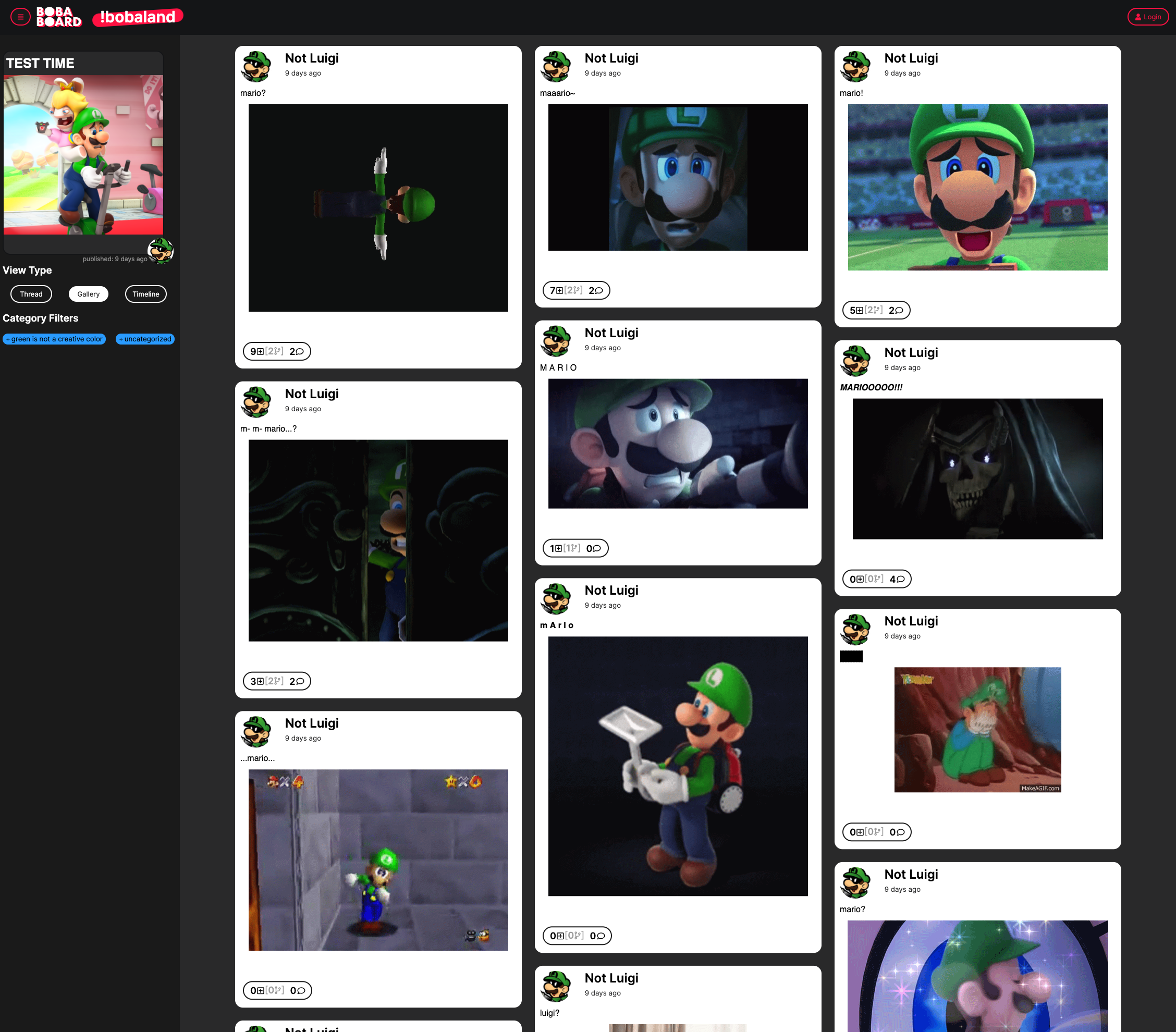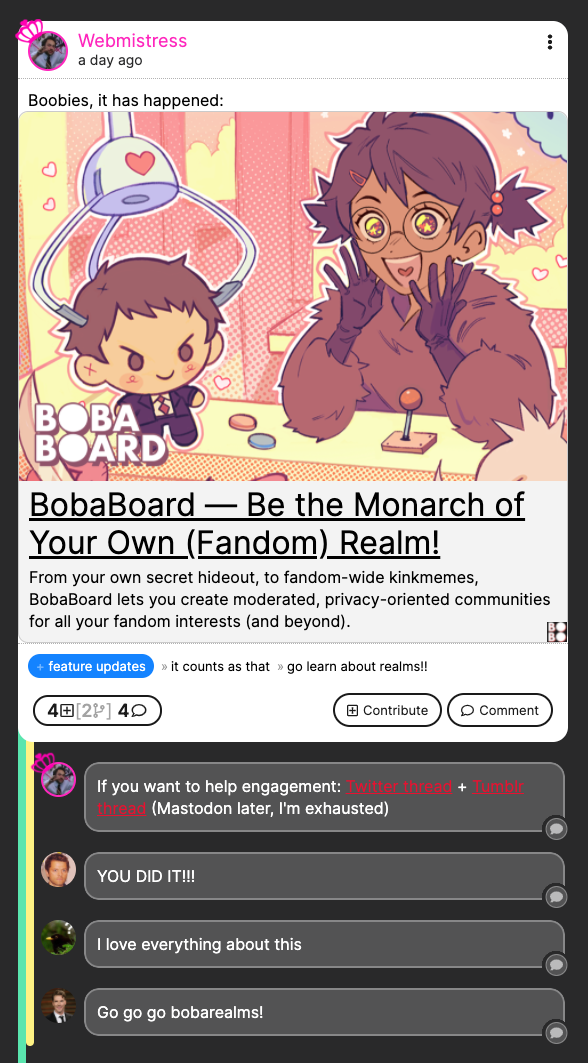Features Deep Dive
Want to know more about what “life on the Boards” will look like? Buckle up, cause it’s time to dive right in!
For a more high-level description 👇
You know what they say, “If we want the rewards of squeeing with others about our latest OTP, we have to submit to the mortifying ordeal of being known”. But while that might be the harsh reality of the larger internet, it’s not how things work around BobaBoard.
Joining a BobaBoard Thread is like trying on a new mask: you’re randomly assigned a secret identity, and for as long as you interact within that Thread—through as many comments and contributions as your heart desires—you’ll keep that same identity, just like the other users will keep theirs. Conversations are easy to follow, everyone knows who’s replying to who, and nobody has to watch their back for saying that the movie was indeed better than the book. Then, when you join a different Thread, the process starts again: new identities, new lives, new yous. Zero baggage.

But, you know, maybe your needs can’t be contained within the chaotic randomness of Bobadex identities. Maybe you need real identities for your real needs, be those having a distinct moderator persona, shamelessly roleplaying your most cursed fave, or letting everyone know you’re that fabled anon with a crush on Elizabeth Warren. Well, never fear: on BobaBoard, you don’t have to choose between the Known and the Unknown.
By leveraging the Roles system, Realm owners can create and assign special identities to specific users, allowing them (and only them) to choose when to use those identities. This allows users to slip in and out of many characters, filling different roles as they see fit, all without being forced to reveal data about their original account, the other conversations they’ve joined within the Realm, or what they’re up to in other communities.

Still, maybe the anonymous life isn’t for you. Maybe you’re in the habit of being loud and proud about your online presence, and no amount of “anonymity is weirdly addictive, I swear!” will convince you otherwise. If so, we’ve got your back: while BobaBoard’s anonymity-first system is a core part of BobaBoard, anonymity-first is not anonymity-only. Different communities have different needs, and if a community requires its members to have actual stable identities, then—pending implementation—actual stable identities, likely selected upon joining the Realm, its members shall have.
Once again, BobaBoard’s philosophy is not to force you into our own view of what’s fun, but to help you choose which communities to join based on your own way of doing fandom. If you’re a rarely spotted cryptid who only comments once in a blue moon, you won’t ever have to reveal your true username; if you’re a personality who simply can’t be contained, you won’t ever have to hide your true username; and if you’re just someone who’s trying to get by, you can pick and choose when to reveal or hide yourself.
Yearning for something a bit more specialized, like, say, letting your friends see your stable identity in a Realm’s !wips Board, but not in !deaddove? Not to worry, so are we!
While it’s still too early to know the final shape of the feature, we want you to be able to adjust your exact flavor of anonymity to your heart’s content, and always be able to grant or revoke identity-sharing privileges as you see fit, where you see fit.

“Good tagging”, it’s a tale as old as time. We’ve all been there, searching for a tag and either getting way fewer results than we absolutely know there must be, or way more. Like, way, way more. Why can’t people just tag right?
Well, tagging’s hard, and the rigidity of most existing tag systems definitely doesn’t help. That’s where BobaBoard comes in with its four tag types, none of which you’re obligated to use—unless, you know, you join a community with specific tagging requirements.
But you know what they say: bullet points speak louder than words. So, without further ado, here’s a rundown of BobaBoard’s tagging system.

- First up, we’ve got the ever popular whispertag! Love it or hate it, unbridled screaming in the tags of a Tumblr reblog was a tried and true tradition. Well, it turns out whispertags are alive and well on BobaBoard, and this time, with commas. Unlike ‘true’ tags, whispertags never show up in any sort of tag search. Feel free to scream with all your might! No one will stumble across your post, just because you had to yell the name of your fave.
- Next, we’ve got the classic #tag. When you input # in a contribution’s tag field, the resulting tag behaves exactly how you’d expect, and will show up in global search… When we implement it (we swear, it’s coming).
- The primary purpose of tags preceded by the + character—the so-called ‘category tags’—is filtering rather than searching. Contributions tagged with them can be found with a single click, both in a single Thread or throughout an entire Board. And yet, while easily filtered for in context, they won’t show up in global search, allowing you the freedom to categorize your own content without worrying about the wrath of those following a particular tag.Still not sure how to use categories? Here’s a tip: tagging
+promptsand+fillsin a kinkmeme Board make it really easy to find what exactly you’re looking for.Want another example? The
+vent onlyand+advice welcomecategories have really helped BobaBoard’s !brains community being confident about the type of interaction requested by a Thread!
- Last but not least, we have content notices! Known by many names, Content Notices always serve the same basic function: informing the audience of content they’re about to view, before they view it. That’s why here at BobaBoard, Content Notices are the only tags placed above a post, enabling a user to either hide the post right then and there, scroll by really fast, or take their sweet time consuming it. Content notice tags are entered by typing cn: into a post’s tag field, and, once again, cannot be searched for.

Of course, these four types can be mixed and matched however you please! But if this system seems overwhelming at first, rest assured: experience tells us you’ll get used to it quite quickly, and will never settle for simple tags again.

With every great fandom platform comes the inevitable rise of a Sexyman (or several dozen). BobaBoard will be no exception, and when—not if—he comes, there will be two types of people: those who welcome him with open leg— arms, and those not strong enough to go through the whole ordeal again. Whether you can’t get enough of Sexymen or want to avoid them as much as possible, we hope BobaBoard’s structure will be able to help you.
Behind even the greatest Sexyman, there’s a story of humble beginnings—a really exciting, exhilarating time for those of us who welcome them. The problem? During the Sexyman Inception Phase, it’s really hard to find someone to scream about them with. Sure, you could yell in the tags. However, unless you provide something substantial to go with it, you can’t help worrying that no one will care, or worse, that your squeeing will get someone excited about the updated tag only to find your incoherent keysmashing staring back at them. Eventually, your carefully crafted excitement gets a single like from a random blog, and no one follows you back to scream about the Sexyman. Your disappointment is immeasurable and your day is ruined.

But what if you could easily find your fellow Sexyman-lovers? This is where Threads, Boards, and Realms come into play. When you have an entire community dedicated to your passions, finding someone to strike up a no-pressure conversation with becomes much simpler. Not only that, but you can have several distinct conversations at once, with more than one person, and from more than one angle.
Imagine it. You’re back from the latest Sexyman-originating movie, The Avengers (2012). You log onto BobaBoard, you use the search function to look for the appropriate Realms, and you get to work:
- In MarvelFans!movies—that is the !movies Board in the MarvelFans Realm—you post, “Fellow intellectuals, what did you think of the characters? That Loki guy sure is something!”
- In AvengersSlash!kinkmeme, after a quick and easy review of potential content restrictions, you select the
+prompt,+The Avengers (2012), and+Lokicategories to make your Need™ for some good Loki/Hulk-smashing known. Of course, as required by Board rules, you add thecn:agegaptag since, after all, he’s 1500 years old. - Next, as your search for the perfect screaming hubs leads you around the Bobaverse, you open up every Gallery you see, full of Loki content collected from all over the web. Delighted, you carefully select the best pieces and add them to your own Loki Thread in the GoreLovers Realm, where your friends (whose taste you’ve personally vetted) can happily join in with their own findings.
While the [Realm Name]![Board Name] naming convention has not yet been established, it’s Ms. Boba’s intention to aggressively advocate for it. If nothing else, for the extremely delightful possibilities offered by Boards in the Top/Bottom Realms.

Now this is all fine and dandy if you do like the Sexyman. But what if you refuse to accept them as your Lord and Savior? Well, structured communities make it easier to avoid topics too. Though the spread of Sexymen is impossible to fully contain, Threads, Boards, and Realms help relegate them to specific corners of the site.
Imagine it (again). You’re back from The Avengers (2012), and you can just smell the rise of the Sexyman in the air. You log onto BobaBoard, and you get to work:
- As soon as you see a Loki Thread appear in your favorite Board, MarvelFans!movies, you hide it, never to be seen again.
- In AvengersSlash!kinkmeme, you update your settings to automatically filter out every thread tagged with the (combined)
+Loki+The Avengers (2012)categories. - Now, after blocking the
#Lokisearch tag, you can merrily look for all the#Tony Starkcontent, knowing that any forbidden Thread, Board, and Realm will be automatically hidden for you.
Here at BobaBoard, we believe that platforms shouldn’t constrain users within standard views, but give them tools to fulfill all their needs: discuss what they love, showcase what they like, and blog about what they live.
This is why our Threads come in 3 flavors: classic, gallery, and timeline.
- Thread view is the classic branching display. Great for discussions, with each subsequent post easily able to be traced up to its originator. Subthreads are automatically collapsed if they’re tagged with blocked content notices, and you can also manually hide the less interesting ones.
- Gallery view brings content front and center. Great for collections, it displays posts side by side as tiles, hides comments away until clicked on (unless you’re specifically looking at the “New” tab), and, paired with the filtering functionality in the sidebar, allows you to quickly find the content you most care about, and even share a specific view with your friends.
- Timeline view highlights the sequential nature of its updates. Great for liveblogging or any type of, well, blogging, it can display contributions in chronological order, reverse-chronological order, or, for a quick catch-up, only the updates.

But our commitment to flexible creativity extends way beyond different views. As another example, you can add your thoughts to a Thread in two different formats: Contributions and Comments.
- Contributions are great for long, complex additions. Featuring embeds, tags, and a card-like display format, they most closely resemble Tumblr posts.
- Comments are great for quick replies or reactions. With restrictions to the their length (and some restrictions in the type of formatting they allow), they most closely resemble Twitter threads. Unlike Twitter threads, however, multiple chained comments are still presented in a compact, unified view, making conversations easier to follow.

Taking a step back: why do we need different types of additions? While we’ve just begun to explore all the possibilities (we’re sure, after all, that our users will keep surprising us with their creative usage), here are some examples:
- Kinkmeme-style Threads can use contributions vs comments to make it easier to find unfilled prompts and separate excited keysmashing, requests for details, and “+1”s from the fills most users are there for.
- In a similar fashion, Gallery Threads use the separation to enable a clean view of the collected content, making users less self-conscious about adding their thoughts and ruining OP’s carefully crafted #aesthetic.
- Last (though yet to be implemented), Realm, Board, or Thread admins can use our fine-grained permission mechanisms to restrict who can contribute in their specific domain, while still allowing others to interact through comments.
Having trouble imagining use cases for limiting contributors? Examples include: RP participants keeping the spotlight on their content while still allowing the peanut gallery to aww and cheer them on; group of friends with compatible tastes collecting content in galleries; or livebloggers making sure no one disrupts the flow of their adventures.

We also have heavily invested into our text editor, which can not only search for The Perfect GIF and spoiler text or images as needed, but also embed just about anything. Furthermore, given its open-source nature, we hope BobaBoard’s users will help us continue to extend its capabilities way beyond our current imagination. Or, if they need some ideas: emojis, sparkletext, “photoset-like” features, “read more”, quotes, inline tags... the possibilities are endless!
When it comes to communities, we’re used to splitting users into ‘moderators’ and ‘everyone else’. But that’s not how communities operate in practice: some people can be really good at breaking up conflicts, but can’t consistently run an event; others might excel at event-running, but balk at the idea of playing mediator. For every strength that a potential ‘mod’ may have, chances are they also have a weakness, or at least duties they absolutely hate fulfilling.
To reflect this flexibility, BobaBoard implements Roles. Similar to the Discord counterparts they’re inspired by, Roles can be used to split duties (and pleasures!) across the community. Do you seethe when something is posted in the wrong place? Do you pride yourself on your ability to defuse situations before they escalate? Do you love organizing events, making sure all announcements are made at the right time and all content is correctly categorized, but can’t be hassled to manage anything outside of them? Whether they’re relegated to a Board, or a Realm, or maybe even one Thread, Roles and permissions make it possible for everyone to find (or be assigned) their place.
- Giving specific users the ability to add alt text where missing.
- Governing both the creation and visibility of Boards.
- Preventing those without (or with!) specific Roles from creating Threads or adding contributions.
- Allowing users to use special identities, like Webmistress or Event Host.
- Moving Threads to other Boards.
- Fine-grained editing permissions for Threads made by other users (enabling, for example, kinkmeme managers to correctly categorize prompt and fills, or fix the lack the compulsory content notices, without also granting the ability to add searchable or whisper tags).

But as usual, we want to take things a step further: rather than restricting roles to being useful, we want to make them fun. How, you ask? Well, what about giving users that complete NaNoWriMo a special “pen and paper” accessory to identify themselves with? Bestowing the exclusive “Luigi-Fucker” Role to those with significant contributions to His Cause™, which grants them posting privileges on the exclusive !luigi Board? What if particularly infamous users at the core of special Realm events could choose to identify themselves in other Threads as needed (looking at you, previously-mentioned “anonymous user with a crush on Elizabeth Warren”)?
With Roles, our goal is to once again build a flexible tool we hope our users will surprise and delight us with.
Crave More?
Want to leave feedback? Suggest improvements? Head straight to the new Open Feedback Form (Realms Era Edition)!
And, if you haven’t checked it out yet, our Realms overview contains much, much more info on the nature of BobaBoard: